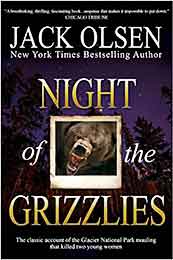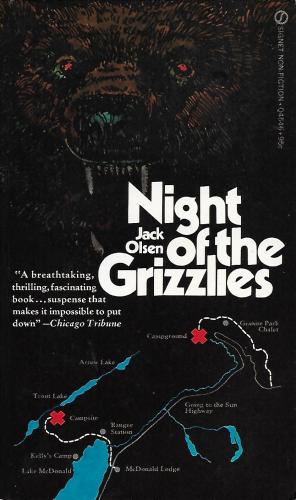 By JACK OLSEN (Signet; 1969/71)
By JACK OLSEN (Signet; 1969/71)
This factual account of a double bear attack in the summer of 1967 was a groundbreaker in its day. The relentless narrative, packed with episodes of extremely graphic carnage, directly anticipated game-changing genre novels like FIRST BLOOD, THE RATS and OFF SEASON (whose author, the late Jack Ketchum, identified this book as a key influence).
NIGHT OF THE GRIZZLIES began life as an assignment for Sports Illustrated, which led to a series of articles that formed the impetus for the book that resulted. The author was the celebrated crime reporter Jack Olsen (1925-2002), who added a lengthy prologue to pad the articles to book length. That prologue, alas, is the weakest portion of the text, an overwritten paean to the natural beauty of Montana’s Glacier National Park, where the drama took place, and its attendant fauna (“Long before one sees the first Columbia ground squirrel or Selkirk marten, one inhales the heady fumes of balsam and picks a path through thick stands of lodgepole pines…”), the grizzly bear in particular.
Further padding occurs in the opening chapters, in which we’re subjected to more scene setting and character development—centered on characters who frankly aren’t very interesting. Yet we’re also shown how events converged to bring about the bear attacks that provide this book’s raison d’etre.
The major culprit in the disaster was the downright-horrendous management of the National Park Service. Olsen claims the NPS “cleaned up its act” after his Sports Illustrated articles initially appeared, but as related in these pages the decisions of its overseers in the summer of ‘67 bordered on criminal. Among the NPS’s many questionable edicts were the allowance of civilian camping in the middle of a grizzly bear habitat and the provocation of nightly bear fights for the edification of Glacier National Park’s ever-swelling tourist population.
Most damaging of all, the NPS ignored the numerous reports of an especially temperamental grizzly terrorizing people in the area. As Olsen makes clear throughout the book, man and bear are naturally antagonistic, and bound to clash sooner or later despite the grizzlies’ seemingly shy and retiring nature: “The grizzly needs space, and the continental United States no longer has space to give him. If he is denied running room, and the human animal continues to bump against him in ever-increasing numbers, the grizzly will maim and kill.”
The tipping point occurred on the night of August 13, 1967. It was then that, in a coincidence that even Olsen has trouble justifying, two young women campers in the Glacier National Park were attacked by two separate grizzly bears. Olsen relates the particulars of this brutal saga in methodical minute-by-minute fashion, building up a great deal of suspense and outright terror. The text may be a bit overwritten by modern standards (and would have benefitted from the ultra-spare prose of the abovementioned FIRST BLOOD and OFF SEASON), but does its job nonetheless.
The real horror of this tale arguably occurs after the events of August 13, when a couple dozen grizzlies were summarily slaughtered. This only served to widen the chasm between bear and man, and led to further attacks. Toward the end of the book Olsen opines that before long “The grizzly will be exiled and then destroyed…he will be lost forever, along with the wild frontier on which he lived his final few years.” Thankfully that has yet to happen, but clearly it’s only a matter of time before it does.

